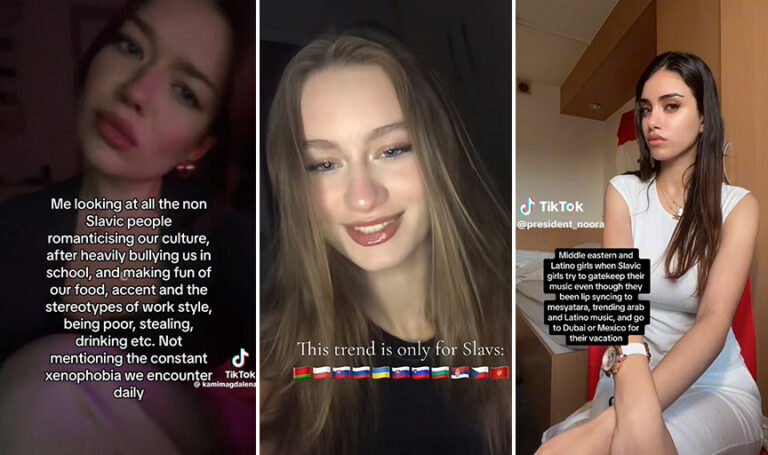Explaining the absurdity of gatekeeping in TikTok’s viral Slavic Girl trend

#Slavtok and Slavic women are having a big moment right now, and as a Slavic girl myself, I absolutely love to see it. In case you don’t know what I’m talking about, I am referring to the Slavic Girl trend on TikTok, which is a recent trend that has already been viewed more than 380 million times, and counting.
Essentially, the trend consists of people all around the world filming themselves dancing in fur coats and hats, scarves, and other winter accessories to the Russian version of the song ‘Moy marmeladniy’ (which directly translates to “my sweet” or “my gummy”) by Russian singer Katya Lel. The format attempts to pay homage to the aesthetic, beauty, and winter fashion worn by so many Slavic women from regions such as Eastern Europe, the Balkans, the Baltics, Central Asia, and parts of Central Europe.
While it is unclear who initially sparked this trend, it has largely been attributed to Slavic women. Nonetheless, women all over the world started joining in. At first glance, this sounds wonderful, and like just another innocent trend—but because this is the internet, naturally, things quickly got out of control, and somehow it is now being used to pit women against each other. So what exactly is the problem here? Let’s get into it.
Well, first and foremost, a small fraction of Slavic women on the platform are saying that only Slavic girls should be allowed to partake in the trend. They argue that anybody partaking outside of these countries is causing offence.
@ssyuta ♬ оригінальний звук - musicdem🎱
@bruhwhat398 bimbo russe 🥰 les gens qui disent chapka pour ushanka 💀
♬ оригинальный звук - scar1exa
Some of the girls say it causes offence because it takes the spotlight away from Slavic women, while others reference the fact that they find it hurtful to see parts of their culture and aesthetic be turned into a trend, while previously being mocked for it.
@kinga_ludwin #fyp #easterneuropean #polishgirl #foryoupage #london
♬ оригинальный звук - scar1exa
@kamimagdalena So now its fun huh?
♬ Мой мармеладный (Я не права) - Катя Лель
It is true that a huge amount of Slavic people have endured xenophobia and suffered bullying due to the stereotypes surrounding these countries, their accents, their foods, cultures, and so on. However, this trend is doing the complete opposite of that—it is not mocking Slavic people or their culture, but rather, appreciating a small fraction of it.
If you look at how Slavic women have been represented on a wider scale in the media and on the internet so far, you will find many problematic tropes. Women from these regions are often falsely perceived and presented as either extremely conservative, traditional, and ‘prude-like’, or desperate, ‘slutty’, ‘fake’, and so on. Then you have the stereotype of the ‘Russian mail order bride’ often attributed to many Slavic women who relocate to Western countries, subjecting them to scrutiny about how and why they moved.
Then, there are also the false xenophobic stereotypes of Slavic people of all genders being poor, uneducated, unskilled, or alcoholics. There are trends on TikTok like #gopnik, which essentially humour the Eastern European equivalent to the British ‘chav’. But the Slavic Girl trend does not play into any harmful or xenophobic tropes. It is not offensive or crass. It is, of course, not representative of all Slavic people—not everyone chooses to wear fur or indulge in this specific aesthetic—but you also can not represent the entirety of a culture through a 10-second TikTok video.
@charlie.dior1 The British have Roadmens the Russians have Gopniks :)
♬ Money so big instrumental - loumy 🇭🇹
Other critics of non-Slavic people participating are doing it purely for gatekeeping reasons. They purposely exclude others by stating that “only Slavic girls can do this,” that fur or a specific song is for “Slavic girls only,” or that only Slavic girls can pull it off or “look good” while participating. This inevitably ends up pitting women of different nationalities against each other.
@angelika_lazuta this song>> #foryoupage #fypシ #xyzbca #slavic #trendin #viral #рек #рекомендации
♬ оригінальний звук - musicdem🎱
@fhlouwn ♬ оригінальний звук - musicdem🎱
The Slavic women complaining about women of other nationalities taking part in this need to acknowledge that they too may have partaken in trends that were created by and for people from other cultures. There is no need to put other women down—everyone looks great while participating in this celebration of Slavic aesthetics.
The song featured in the trend is Russian, although sampled from a Romanian song, and Russian is the predominant language only in one Slavic country out of them all, which is Russia. Therefore, assesting that only Slavic women are allowed to listen to, dance to, or appreciate the song would be wrong.
There is nothing in this trend that would make it offensive for others to partake in. Fur coats, fur hats (many of which that we see worn in this trend are, thankfully, faux fur), or winter accessories do not exclusively belong to Slavic cultures. Historically, fur was used as a necessity in many colder Slavic climates where the temperature reached lows such as -62°C. But it has also been worn in countless other countries and regions in the world—both as a necessity to keep warm or as a status symbol.
@candybomb_0206 I’ve seen so many slavic girls trying to gatekeep this trend 🙄 not all of us share the same opinion, many of us don‘t mind🫰 ・ ・ ・ #slavicgirl #slavic #ukranian #russian #slavicgirltrend #stopgatekeepingeverything
♬ оригінальний звук - musicdem🎱
At the end of the day, it’s just an innocent TikTok trend, and in this case, anyone should be able to participate, without the fear of gatekeepers going after them.




